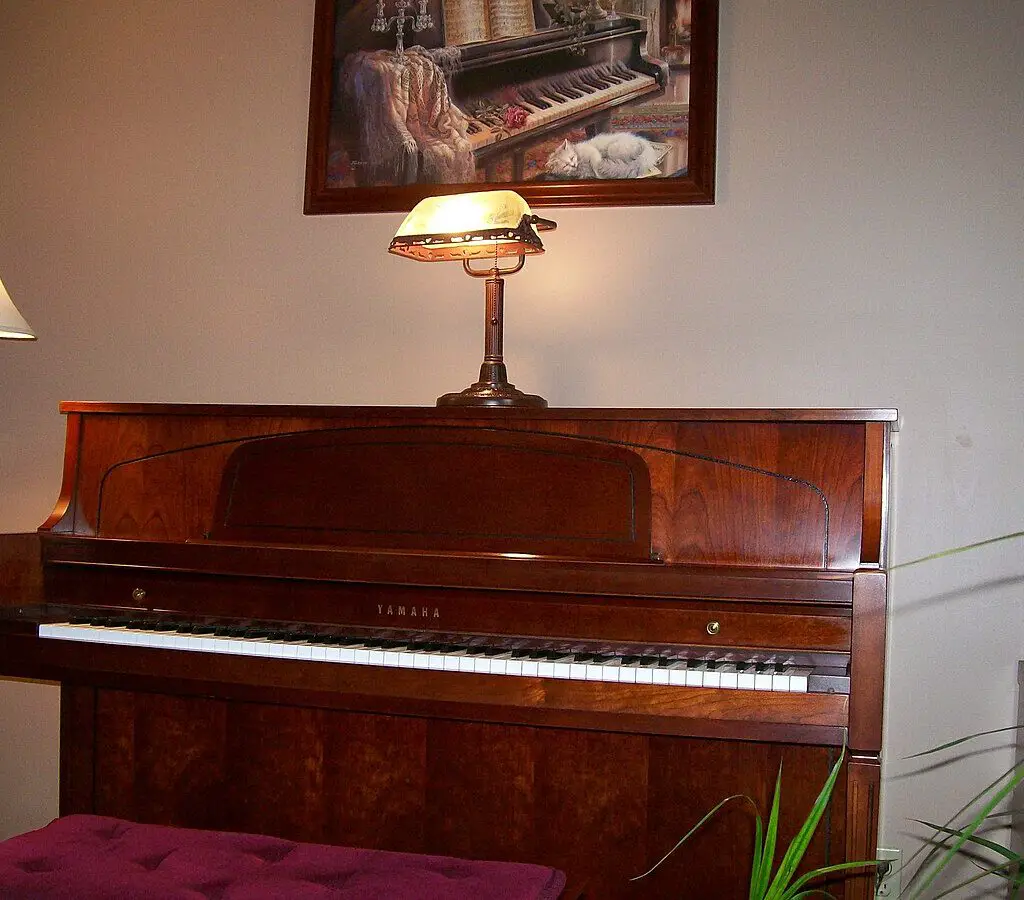If you’re wondering “what’s a piano lamp?”, you’ve come to the right place. A piano lamp is not just a decorative piece; it’s an essential tool for both amateur and professional pianists. In this article, we’ll guide you through everything you need to know to make an informed choice.

Table of Contents
What’s a Piano Lamp and Why Do You Need One?
The piano is a nuanced instrument that requires your full attention to detail, from finger placement to reading sheet music.
Poor lighting can lead to eye strain, mistakes in your performance, and can even affect your posture as you lean in to see the keys or music better.
A piano lamp eliminates these issues by providing focused and adjustable lighting to make your practice sessions or performances more comfortable and efficient.
The right lighting conditions significantly enhance your ability to see small details on the sheet music or subtle differences in key shades.
This clarity is particularly beneficial for beginners who are still familiarizing themselves with the instrument and for professionals who play complex pieces that require utmost precision.
Types of Piano Lamps
Choosing a piano lamp can be overwhelming given the different types available. Below we break down the key attributes of each type to help you make an informed decision.
Clip-On Lamps
Portability: Clip-on lamps are generally small and can be easily moved from one place to another.
Space-saving: Because they attach directly to the music stand or piano, they don’t require extra table or floor space.
Focused Lighting: These lamps are designed to illuminate targeted areas like your sheet music or keyboard.
Limited Range: Clip-on lamps might not offer sufficient lighting for larger pianos or broader music stands.
Attachment Concerns: Over time, the clip mechanism may wear out or could potentially scratch the surface to which it is attached.
Upright Lamps
Strong Illumination: Upright lamps usually offer a broader and more powerful light range, suitable for grand pianos.
Stability: They are generally sturdier and less likely to be knocked over compared to clip-on versions.
Space Consumption: These lamps require extra space, either on a table or on the floor, which may not be ideal for smaller rooms.
Less Portability: Due to their size and design, upright lamps are less mobile.
LED Lamps
Energy Efficiency: LED lamps consume less power, reducing your electricity bill.
Longevity: LED bulbs last much longer than traditional incandescent or halogen bulbs.
Brightness Options: Many LED lamps come with adjustable brightness levels.
Initial Cost: LED lamps can be more expensive upfront, although they often save money in the long term due to their durability and energy efficiency.
How to Choose the Right Piano Lamp
Choosing the right piano lamp involves considering various factors such as brightness, adjustability, and aesthetics. Here’s how to go about it.
Step 1: Assess Your Lighting Needs
Here’s what you’ll need to do…
Evaluate the Room
Begin by assessing the lighting conditions in the room where your piano is located. Note if the room has natural light, if there are other light sources like ceiling lights, and how well they illuminate your piano. Take note of darker hours like evening times to get a fuller picture of your lighting needs.
Understand the Purpose
Are you using the lamp solely for practicing, or do you have performances where clear visibility of sheet music is crucial? The purpose will influence your lighting requirements.
Step 2: Check the Brightness and Adjustability
Make sure the lamp you choose offers a range of brightness levels. This is crucial as you may need different levels of light for different situations, such as playing at night versus during the day.
Check if the lamp allows for adjustments in height and angle. The ability to direct the light exactly where you need it is crucial for optimal visibility.
Step 3: Consider the Aesthetic Appeal
Your piano lamp should not only be functional but should also match or complement your room’s aesthetics. Consider the color scheme, style, and even the shape of the lamp to ensure it harmonizes with your space.
Whether you have a grand piano or an upright, the lamp should match your instrument’s style. For example, a sleek, modern lamp may look out of place next to a vintage, wooden piano.
Step 4: Set a Budget and Shop
Before you start shopping, decide how much you are willing to spend. Piano lamps can range from affordable to high-end models with additional features.
Browse various online and offline stores to compare prices and features. Reading customer reviews and expert recommendations can offer valuable insights into the lamp’s performance and durability.
Once you’ve weighed all the factors, go ahead and make your purchase. If possible, opt for a lamp with a return policy so that you can try it out and return it if it doesn’t meet your expectations.
For more articles on piano questions, click here: Piano Questions: Your Ultimate Guide to Understanding All About Pianos
Conclusion: What’s a Piano Lamp?
Now that you know what a piano lamp is and how to choose the right one, you’re well on your way to creating the perfect environment for your piano playing. A good piano lamp can make a world of difference in your performance and enjoyment.